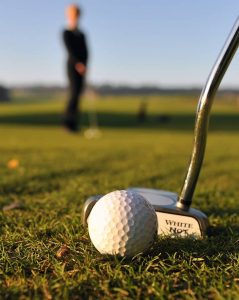Table of Contents
Introduction
Putting is one of the most straightforward aspects of golf that is mostly overlooked by golfers. Many golfers find putting challenging to do. Even, Some golfers refer to putting as another kind of sport. They belief golf is done in the air, putting is done on the ground. This is all because of how frustrating it can be. If you watch golf on TV, you will see that some golfers are good with their drive, they can drive the ball consistently to about 300 yards, but when it comes to putting, they perform awfully. Putting is what separates the great golfers from the good ones. Even though it looks so easy to do with just a stroke as compared to a swing when driving, many golfers still struggle with putting on the greens. Struggling with putting on the greens can be because of the lack of the necessary skills such as movement control, distance control, reading the greens and so on, there is one other factor that is critical to successful putting. This is a putter. Your putter is the last weapon that you should have in your bag when standing on the green. You should get yourself the best putter that works best for your kind of stroke. Therefore, if you are struggling with your putting, it might not be you, it could be your putter. This is why this guide has been made for you, especially to show you how to choose a putter. Read through the guide to discover all you need to get a properly fitted putter and start to putt just like the pros
How to Choose a Putter in just Seven Steps
You can quickly begin to lower your scores by putting with the right putter. Here is all you need to know about how to choose a putter
1. Know your putting style
Before you can select the right putter for yourself. You should know your putting style first. This factor is so important because once you have known your putting style, you will naturally know the right putter that best fits you. Many golfers overlook this factor and go straight to buying anyhow putter. Their game will later suffer. To avoid this, figure out your natural stroke. There usually are two types of putting style stroke. These are the long swinging stroke and the short popping stroke. Depending on the kind of stroke you use, getting a putter that matches your natural stroke is the only weapon that can help you to improve in your putting gradually

2. Putter length
Once you have identified your putting style, it is time to get the putter. Due to the different lengths utilized when making the stroke based on the type of stroke you use, you should consider the putter’s length too. Many golfers use putters that are too long, which makes their strokes awful. Instead, get a putter that will give you the right posture at address. At address, you want your eyes to be over the ball, hands not too high and too low, your wrist arched downward, your feet providing stability with little movement as much as possible, your arms and shoulders aligned with the shaft. Therefore, the putter you must choose must fit this set up properly. If you hold the putter and find out that you are gripping the down shaft, then you need a shorter putter. However, gripping beyond the end of the putter means you need a longer putter. Choosing the right putter length will ensure you the right posture at the address
3. Get the right head shape
This has to do with individual preference, and the individual preference depends on the stroke path. In golf, there are two-stroke paths which include the arc stroke path that appears curved (when the putter is taken inside slightly and then open the face on it way back) and a straight path that appears to be in a straight line when the stroke goes back and forth. Depending on your stroke path, if you are more inclined to an arc path, then a blade putter is the best for you. A blade putter is simple in design, and it looks like a traditional putter. They are the oldest type of putters made, and it is still commonly being used some professional golfers today. The sweet spot of this putter can be difficult to locate if you are not inclined to it. It has more weight in the toe, which makes it easier to do the arc stroke.
If a straight path is your forte, then a mallet putter is all you need. The mallet putter is strictly designed for you because it is larger and more square to aid in making your stroke straight back and through. It has a good weight distribution because of its face. So you can be sure this will balance well to make your stroke. However, there is another type of putter head that is gaining popularity now; this is the high MOI. Pro golfers commonly use it at the tour level because it provides an awesome putting experience. You can do well to check some this kind of putter heads out
4. Balance point
Once you have identified your stroking style and path, putter length, head, the next thing is to know the balance point of the putter. Some putters are face-balanced while some are toe balanced. This depends on the kind of shaft that comes with the putter. We have the centre-shaft putters and heel-shaft putters. The centre-shaft putters are the ones that are faced-balanced. You can identify such putters by laying the shaft on your hand parallel to the ground if it faces upward, you have a face-balanced putter. The face-balanced putters (centre-shaft) can be used by a golfer that has a straight line stroke path as the putter can hit squarely on the ball due to its weight distribution
The other type of putter is the toe balanced. This is found in heel-shafted putters. It can also be identified if it hangs down when laying on the hands. This form of putter benefits golfers that use the arc stroke path because the putter face opens and close to the target which makes it easy to rotate the head to make the ball travel on a slight curve.
5. Loft
In most cases, golfers associate the loft with their drivers, wood, and irons. The putter is so overlooked that its loft isn’t considered. The loft keeps the ball rolling in places with depression. However, if you have too much loft on the putter, it can give the ball some backspin effect. You will notice the ball bouncing and hoping when hit. Also, a putter with a small loft can lead to sloppy putts. The ball will sway from its course due to its bad roll. Golfers with the forward press, using their hands to make an impact will need a putter with a more loft because their motion, when they move backwards, deloft the putter. Golfers who eat up on the ball will need a putter with less loft. Generally, most putters come with loft ranging from 2 to 4 degrees depending on the brand. Some brands manufacture putters ranging from 3 to 5 degrees of loft.
6. Weighting
We have talked about the balancing point as well as the head shape of each type of putter. It is now important to know about the weight of the putters. Each putter has its center of gravity depending on the balancing. The weight of the putter plays a role in determining your stroke path also. The putter’s length also affects the weight. If you use a short putter like 32″, you should get like 375 to 385 grams head weight, if you want a 35″ putter, prepare for head weight with 330 grams

7. Lie angle
The last but not the least is the lie angle. All putters have their lie angles, but most of the putters come with a 70 degrees lie angle. Choosing a putter that has the right and proper lie angle will allow you to always be in a good posture at the address when preparing to take your stroke. It will also help you know the best putter length for you. If you use a putter that is too upright for your setup, the toe of the putter faces up. This will cause the ball to sway to the left from its intended course. Also, a putter that has a lie angle that is too flat for your setup will cause the ball to sway to the right from its intended course. You can know your natural lie angle by holding your putter and standing in the right posture as if you were about to putt, then get someone knowledgeable enough to check the sole of the putter. If it rests flat on the ground, then that it is your right lie angle. The lie angle can always be changed, so there is nothing to worry about.
Conclusion
Getting a good putter that will work for you at any point in time when standing on the green goes a long way to improve your putting. The putter contributes to the skills required for a perfect putting. We implore you to follow the steps above so that you can start to play your putts like the pros. Remember that confidence is earned if you do this. Feel free to check our website for more related informational tips. Ciao for now!
